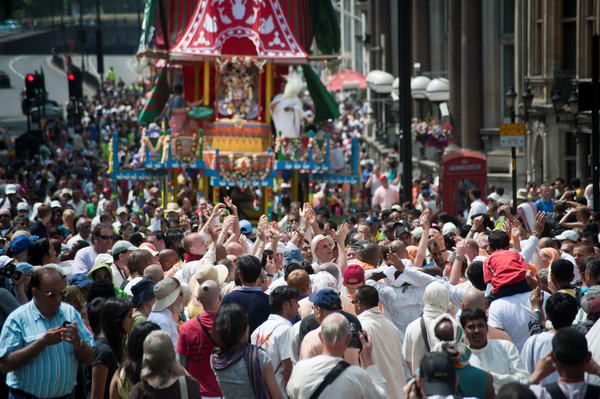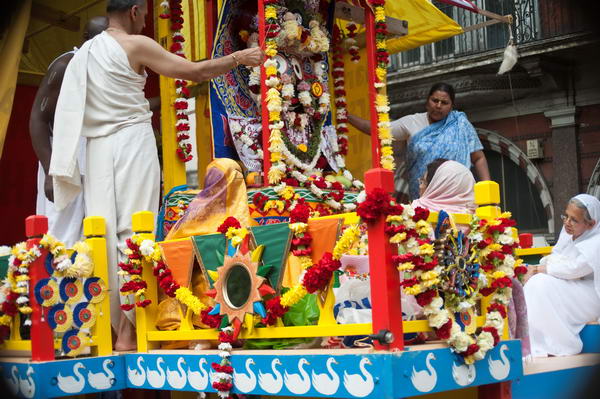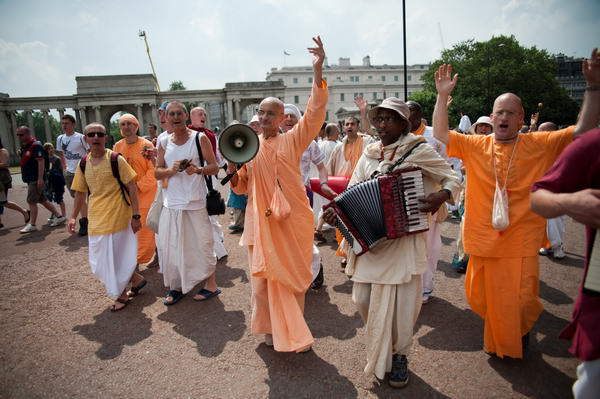
This was the view I got clinging to the side of a crossing light on a centre of the road refuge near Green Park station as the three chariots were pulled up Piccadilly in this year’s Sri Jagannatha Rathayatra Festival. This is the first chariot, the other two are hidden behind it in this picture.
I’m not quite sure why – perhaps it was the effect of heat on my brain – I’d decided to photograph the event with minimum depth of field, working with both lenses I had wide open for almost all the time. This is actually a un-cropped full-frame (FX) image made with a Sigma 55-200 mm DC lens designed for use on DX format only, and shows hardly any vignetting or loss of sharpness – even when wide open at this focal length. Of course wide open isn’t very wide – f5.6 at this end of the range, and this for me was part of it’s attraction when I bought it a few years ago, as it makes for a very compact and light lens – and it was very cheap. I don’t shoot a great deal a long focal lengths, but I’m happy to carry a 350 g lens for the few occasions that I need it.
At the 55mm end – where the lens is f4 – there is some actual image cut-off, not visible in the D700 viewfinder but showing in the slightly larger image on the back of the camera. You can see it on this picture of Jaganattha taken from the same lamp-post:

1/800, f4, 56mm (Exif reports this while the lens is engraved 55mm)
This cut-off is caused by the rather effective cylindrical lens hood – as I found later by using the lens without it (although there is also some partial vignetting – which can be dealt with in Lightroom. I’m thinking at the moment about taking a few mm off that hood with a hacksaw or perhaps ‘petalling’ it with a file, but can’t work out exactly how much it needs to be.
Sharpness does seem surprising good to the edges and corners, although possibly a test chart would reveal weaknesses. But the glasses on the woman in white at the right edge are acceptably sharp, though her ear is a little soft! Of course depth of field – and flatness of field also come into play. The railings and moulding on the balcony at top right actually get noticeably sharper towards the corner of the picture when viewed at 1:1.
It would certainly be useable on the FX format for many purposes – such as portraits – though might be a little lacking for say architectural work or landscape (though I did go on to try it on these later in the day.)
I was surprised at these results – other DX lenses that I have show some very noticeable cut-off – with the Nikon 18-200 at almost all focal lengths. That doesn’t mean that this lens can’t be used on the D700, but it does restrict you to the DX format on the camera, with image files back to the 6Mp that we were used to on cameras such as the D100 – and just a little limiting on image quality. Given that the Sigma is also a better performer at least at the longer end, unless I need the full range of the 18-200, there is now no contest.
The D700 has a feature that will automatically crop the results from Nikon DX lenses if you set it to Auto crop. It’s perhaps good news that this doesn’t work for older Sigma lenses, so I can leave it set for when I feel a need for the 10.5mm fisheye, but don’t need to turn it off when I use the Sigma 55-200 DC.

The procession starts – taken at 24mm, f2.8. Vignetting not corrected.
Although many of the pictures from the event were taken from that same spot above ground as the whole procession passed, I did also photograph more conventionally. For that I was using another Sigma lens, the new HSM 24-70 f2.8 – and working at f2.8. More about this lens at a later date.